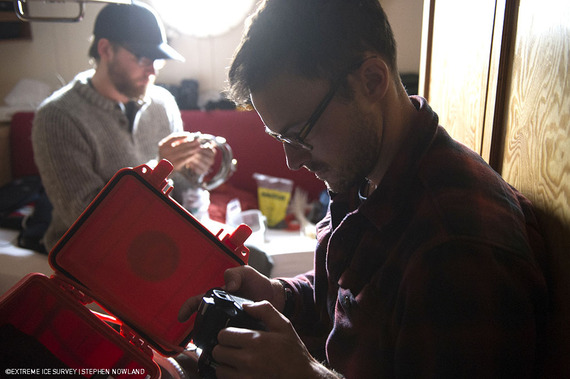Extreme Ice Survey, the team featured in the Emmy award-winning film Chasing Ice, is aboard our ship, the National Geographic Explorer, sailing towards South Georgia Island and Antarctica. Over the next two weeks, they'll be installing time-lapse cameras that will shoot photos every hour of every day, creating visual records of these changing landscapes.
During February 2014, our team traveled aboard Lindblad Expedition's National Geographic Explorer to install time-lapse cameras on the Antarctic Peninsula and South Georgia Island. The camera systems include a Nikon D3200 digital camera, a custom waterproof case and timer, and are completely powered by a solar panel and battery. We typically install cameras on bedrock outcrops above the glacier to ensure sufficient perspective to monitor the glacier's flow and extent. Last year, we installed nine cameras at five different sites, including Cierva Cove and Neko Harbor on the peninsula. We were graced with sunny skies and warm temperatures, and often, friendly visits from the neighborhood welcoming committee, staffed by penguins, and seals.
You can see why authors have long struggled to describe these visually stunning landscapes with words alone. The sharpness of the peaks, the contrasts between ice and ocean, the way the mountains are draped in globs of snow and ice; verbose descriptions of their grandeur fail and that's even before considering the charismatic penguins bathed in soft multi-colored alpenglow. However, despite the idyllic and distant nature of this location, it is one of the fastest changing landscapes on the planet. Atmospheric temperatures have increased by more than 5° F since the 1950s, the majority of glaciers are flowing faster and have thinned and numerous ice shelves (floating extensions of glaciers as large as Rhode Island), have completely collapsed. In short, these landscapes look very different from what they did 50 or in some cases, even 10 years ago.
Over the next month, we'll be returning to remove and replace the memory cards of these cameras and install additional cameras at new sites--including the Marr Ice Piedmont near the U.S. Antarctic Program's Palmer Station and South Georgia Island's magnificent Nordenskjöld Glacier.
We're currently in the Falkland Islands and will be departing for South Georgia Island this evening. We're taking this opportunity to finish building the camera systems prior to the crossing. Stay tuned over the next month as we download our Antarctica images for the first time and install new time-lapse cameras, all in an effort to create visual records of some of the most rapidly changing landscapes on the planet.

